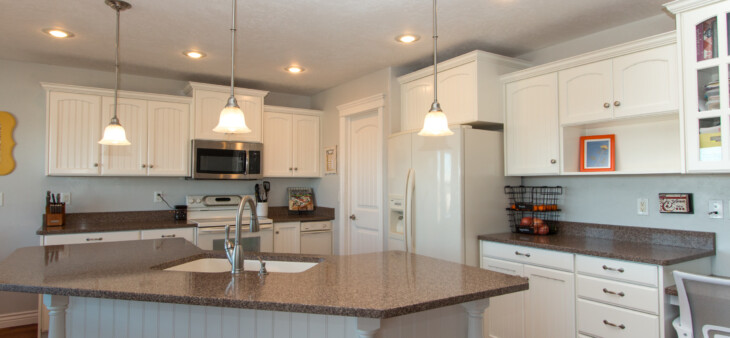Kitchen remodelers love to talk about the value afforded by cabinet refacing. By changing the style and color of your cabinets, refacing completely reshapes the appearance of your kitchen. But because it leaves the original cabinet frames and boxes in place, it costs significantly less than alternatives, like replacing your cabinets completely.
But how much does cabinet refacing actually cost?
The short answer is: “It depends.”
On the low-end — with the cheapest materials possible — you could be spending $1,000 or $2,000. For a large kitchen with high-end materials, the costs could be several times as much.
But that’s not a very helpful benchmark if you’re trying to budget a remodeling project. To get a stronger sense of costs, you’ll need to account for some key variables.
At the same time, you’ll want a sense of how refacing stacks up against alternatives like refinishing, painting, or replacing your cabinets.
What Affects Pricing for Cabinet Refacing?
If you’re refacing kitchen cabinets, a number of variables will affect the cost of your project. Below, we’ve listed four of the most important variables, as well as some additional costs that can impact the price of cabinet refacing.
Cabinet Size. As with any other remodeling project, the size of your space affects the price of your project. If you have a compact kitchen with relatively few cabinets, you can expect to spend less on refacing. But if you’ve got a larger kitchen in which cabinets take up a lot of space, you’ll need to budget accordingly.
Refacing Materials. Refacing your cabinets involves replacing the cabinet doors and covering the cabinet boxes with veneers or a new finish coat. Different types of doors, veneers, and finishes come at different price points and quality levels. The MDF doors and thermofoil veneers used by many refacing services may be cheap today. But they degrade quickly. Higher quality materials, like hardwood doors or a custom finish from N-Hance®, will cost a bit more. But they’ll retain their value for much, much longer.
Door Styles. Any time you’re replacing cabinet doors, the style of doors will impact the costs of your project. Simpler styles — like flat-front and Shaker-style doors — are typically cheaper. More complicated styles — like raised-panel doors — are priced higher, increasing the cost of cabinet refacing.
Cost of Labor. Different cabinet refacing companies will charge different rates for the cost of their labor. As a result, you may receive much higher quotes on refacing from some providers compared to others.
Additional Costs. Refacing your kitchen or bathroom cabinets often comes with additional costs, which can increase the price of your project.
These may include:
- Specialty styles of cabinet doors, such as glass panel doors for upper cabinets
- New hardware installed at the same time as your new cabinet doors
- Painting or custom finish services for cabinet doors, drawer fronts, and cabinet boxes
- Unique finish techniques used to achieve a specialty look
Cost of Cabinet Refacing vs. Refinishing, Painting or Replacement
Another smart way to think about the cost of cabinet refacing is in comparison to the alternatives. How much more does refacing cost compared to refinishing? And how much less compared to a wholesale cabinet replacement?
Because of all the different pricing variables, the cost differential will change from project to project. A high-quality refinishing job can cost as much as you’d spend on a cheap, low-quality refacing project. On a similar note, replacing high-quality cabinets with MDF and laminate cabinetry can cost less than a top-of-the-line refacing project.
But as a general rule of thumb, refinishing or painting your cabinets will cost about 50% of what it would cost to reface them. Meanwhile, a full-scale cabinet replacement will cost anywhere from 150% to 250% the cost of refacing.


